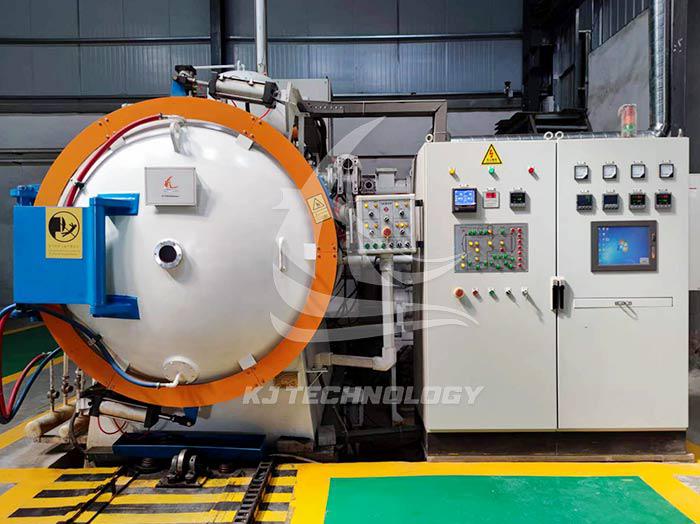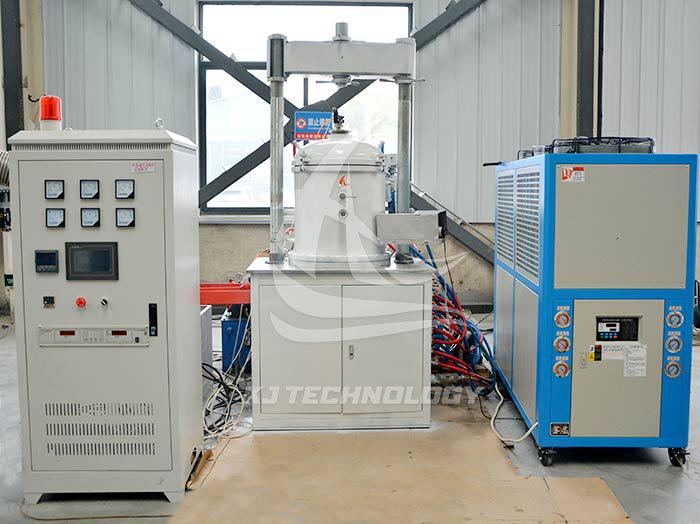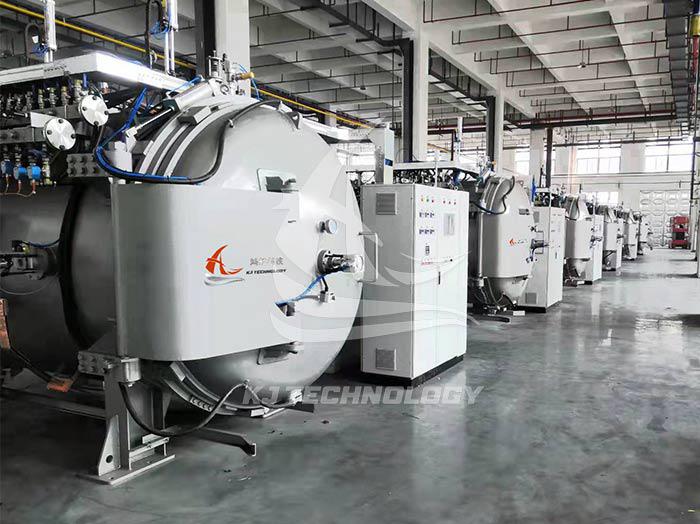Common faults and solutions of vacuum sintering furnace
 03-20-2025 Author: KJ technology
03-20-2025 Author: KJ technology
Vacuum sintering furnaces may encounter various faults during use. Here are some common faults and their solutions:
1. Abnormal temperature
a. High temperature alarm
Reason for malfunction:
Temperature controller parameter setting error.
The output terminal of the solid-state relay is broken down.
Poor contact of thermocouple probe.
resolvent:
Check if the parameters of the temperature controller in the workspace are normal, and refer to other temperature controllers in normal use to calibrate all parameters.
After a power outage, use a multimeter to measure the resistance between the two output points of the solid-state relay. Normally, the resistance should be several megohms or more. If it is broken down, there will be almost no resistance and a new component of the same model needs to be replaced.
When the power is turned on, gently shake the thermocouple probe in the corresponding working area by hand and observe whether the temperature controller displays a large jumping amplitude. If this phenomenon occurs, it indicates poor contact of the thermocouple probe and needs to be replaced with a new one.
b. The displayed temperature is too low to reach the set value
Reason for malfunction:
The thermostat has no output signal.
The thermocouple is damaged.
The heating tube is not functioning properly when powered on.
resolvent:
Check if the thermostat has an output signal.
Check if the thermocouples are damaged by swapping them with thermocouples on a normal thermostat and observing the temperature display. If the thermocouples are indeed damaged, they must be replaced.
If there are no issues with the thermostat and thermocouple, it is necessary to test whether the heating tube is working properly when powered on. After powering on and starting up, start heating. According to the circuit diagram, directly use a test pen to test the wires connected to the heating tube in the corresponding working area (the white high-temperature wire on the solid-state output terminal) to see if there is electricity arriving. If there is electricity arriving, a clamp meter should be used to measure whether the current is different from other working areas. Under normal circumstances, the difference is not significant. If there is no power supply, the circuit must be checked one by one according to the circuit diagram to see which link is cut off and whether any components are burned out.
2. Abnormal vacuum degree
a. Low vacuum degree
Reason for malfunction:
Vacuum pump malfunction, such as pump oil contamination, insufficient or too thin.
The vacuum seal is aging or damaged.
There are air leaks in pipelines, solenoid valves, pipe joints, vacuum pump suction valves, and sealing gaskets around the working chamber.
resolvent:
Check the operation of the vacuum pump, clean the vacuum pump, and replace the vacuum pump oil with a new one.
Check the condition of the vacuum seal, replace aged or damaged seals if necessary, and reinstall seals to ensure sealing effectiveness.
After evacuating, turn off the power, check for any air leaks in the solenoid valve, pipe joints, vacuum pump suction valve, and sealing gasket around the working chamber, and repair them.
b. The vacuum exhaust time is longer than usual
Reason for malfunction:
The influence of air release in different states of vacuum chamber structures.
leak.
resolvent:
Stop the equipment for inspection, and determine whether there is any pressure increase caused by the impact of air release in different states of the vacuum chamber structure.
Confirm the impact of gas leakage or deflation through pressure rise testing or helium leak detection.
3. Mechanical structural failure
a. The door is not tightly closed
Reason for malfunction:
The hinges of the door are loose.
Buckle deformation.
The sealing strip at the door is damaged.
The door panel is deformed.
resolvent:
Check if the hinges of the door are loose, and tighten them if they are loose.
Check if the buckle is deformed, and if so, repair or replace it.
Check if the sealing strip at the door is damaged, and replace it if it is damaged.
Check if the door panel is deformed, and if so, repair or replace it.
b. Pneumatic valve cannot operate
Reason for malfunction:
The corresponding solenoid valve is not functioning properly.
The compressed air pressure does not meet the working requirements.
The pneumatic valve itself is damaged.
resolvent:
Check if the corresponding solenoid valve is working properly, and if not, repair or replace it.
Check if the compressed air pressure meets the working requirements, and adjust if not.
If the air pressure is normal and the solenoid valve is in good condition, the pneumatic valve itself may be damaged and needs to be replaced.
4. Other common faults
a. Heating does not stop
Reason for malfunction:
Poor contact or burnout of the heating time relay.
resolvent:
Adjust the contact between the time relay and the socket, or replace the time relay with a new one.
b. Vacuum sintering furnace oil leakage
Reason for malfunction:
The return valve is blocked.
resolvent:
Remove the return valve for cleaning. If the problem cannot be solved, consider replacing the return valve.
c. High noise level
Reason for malfunction:
The coupling of the vacuum pump is worn or broken.
resolvent:
Replace the vacuum pump coupling with a new one.
d. Blockage of exhaust filter
Reason for malfunction:
The exhaust filter has been used for too long and has accumulated a large amount of impurities.
resolvent:
Clean or replace the exhaust filter and ensure that it is installed in the correct position.
5. Emergency response measures
During a power outage
emergency measure:
If there is a water outage, immediately connect the backup cooling water and water source.
If power can be restored as soon as possible during non heating, heating, and cooling, restart the equipment to continue operating; If it takes a long time to restore power, keep the equipment in its original state.
If there is a power outage while heating and cooling, and power can be restored as soon as possible, restart the equipment; If it takes a long time to restore power, keep the equipment in its original state and let it cool down naturally.
When the cooling water is abnormal
Emergency measure:
The equipment is in a stopped state, immediately connect emergency cooling water.
At high temperatures (over 200 ℃), if the cooling water supply stops and emergency water supply cannot be provided, the heat exchanger, vacuum chamber shell, and pumps of the equipment may be damaged. At this time, measures should be taken as soon as possible to reduce the equipment temperature.
When there is water leakage outside the furnace
Emergency measure:
Take emergency measures as soon as possible. If the cooling water volume can be ensured, please continue to maintain the vacuum; If emergency measures cannot be taken, maintain the original state and confirm that the vacuum sintering furnace equipment has cooled down.
Please note that the above solutions are for reference only. In practical operation, a comprehensive analysis should be conducted based on the specific model, user manual, and fault symptoms of the vacuum sintering furnace. If necessary, professional technicians should be contacted for maintenance. At the same time, in order to ensure the normal operation and prolong the service life of the vacuum sintering furnace, regular maintenance and inspection should be carried out.








